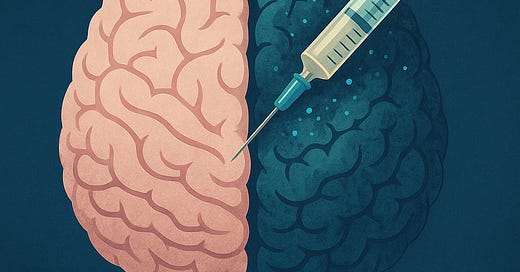Targeted ClO₂ Intervention for Alzheimer's Disease: A Conceptual Protocol Based on the Aging-Destruction-Regeneration Model
By Xuewu Liu
Author of "From Cancer Cure to Rejuvenation: A New Model of Aging and Cellular Replacement"
Introduction: Why Alzheimer's Needs New Thinking
Alzheimer's disease (AD) remains one of the most devastating and poorly treated neurodegenerative conditions. Billions have been spent on failed amyloid-targeting drugs. Cognitive decline continues unabated for millions of patients worldwide. But what if we are looking at the wrong targets?
In my previous work on cancer, I proposed a new paradigm: targeted removal of dysfunctional tissue, followed by natural regeneration, can restore health more effectively than suppressive drugs. This concept, born in the context of intra-tumoral chlorine dioxide (ClO₂) injection therapy, now shows potential far beyond oncology.
What if the same approach can be applied to the aging brain?
The Aging-Brain Crisis and Its Molecular Entropy
As the brain ages, it accumulates metabolic waste, dysfunctional glial cells, senescent neurons, and vascular debris. This entropic burden impairs synaptic plasticity, circulation, and immune balance. While researchers debate amyloid and tau, a more fundamental issue emerges: the sheer accumulation of cellular "garbage."
Aging, in my framework, is a progressive disorder of spatial and functional order. In the brain, this manifests as synaptic disarray, microglial overactivation, and impaired cerebrovascular clearance.
Current Failures of Alzheimer's Drug Strategies
Most Alzheimer's drugs have aimed to inhibit enzymes, modulate neurotransmitters, or clear plaques via antibodies. These strategies often ignore the chronic, layered architecture of damage. They try to influence pathways, but not the underlying physical pathology. Unsurprisingly, results have been disappointing.
The Relevance of the ROS-Mimicking Properties of ClO₂
Chlorine dioxide acts like a precise, controllable mimic of reactive oxygen species (ROS). Unlike systemic ROS bursts that cause collateral damage, localized ClO₂ can eliminate dysfunctional cells and molecules selectively via oxidation of sulfhydryl and phenolic groups. It also neutralizes inflammatory mediators.
This makes it a candidate for targeted, micro-scale clearing of brain tissue compartments suffering from oxidative stagnation.
Aging as Accumulated Dysfunction: From Cancer to Cognition
In cancer, I showed that ClO₂ injected directly into tumors causes rapid cell death without systemic toxicity. More importantly, this ablation is followed by rejuvenation: new tissue, restored blood flow, and better function.
Why? Because the body is intrinsically regenerative when the burden of decay is removed.
The same could apply to neurodegeneration: eliminate what is broken, let the body rebuild. In Alzheimer's, targets include:
Senescent astrocytes and microglia
Extracellular plaque and fibrillar deposits
Inflamed perivascular zones
The Destruction-Regeneration Hypothesis Applied to the Brain
I call this the Aging-Destruction-Regeneration Model. It posits that targeted ablation of aged cells in a tissue compartment can trigger endogenous repair. The key is not total removal, but precision.
Laser dermatology, ablative peels, and fractional RF already use this principle. ClO₂ brings it into internal medicine.
Possible Targets: Senescent Astrocytes, Microglia, and Vascular Plaques
Research shows that microglial senescence correlates with cognitive decline. These cells resist apoptosis but spread inflammation. Astrocytes that lose function fail to buffer glutamate or support neurons. And vascular damage impairs glymphatic clearance.
Localized ClO₂ injections could:
Reduce the inflammatory burden
Create space for new glial growth
Enhance local perfusion
Delivery Strategy: Microdose, Perivascular, and Image-Guided Injection
Key to safety is delivery. No systemic administration. Instead:
Ultrasound or MRI guidance
Nanoliter or microliter-scale injection
Targeting perivascular or subpial zones
Use of flexible microcatheters under sedation
Mechanism of Action: Clearance, Modulation, Rejuvenation
ClO₂ clears debris through oxidation.
It modulates local immune cells.
It creates micro-wounds that trigger repair.
It improves redox signaling and suppresses LPS-type inflammation.
Together, these lead to regeneration.
Keep reading with a 7-day free trial
Subscribe to Xuewu Liu’s Substack to keep reading this post and get 7 days of free access to the full post archives.




